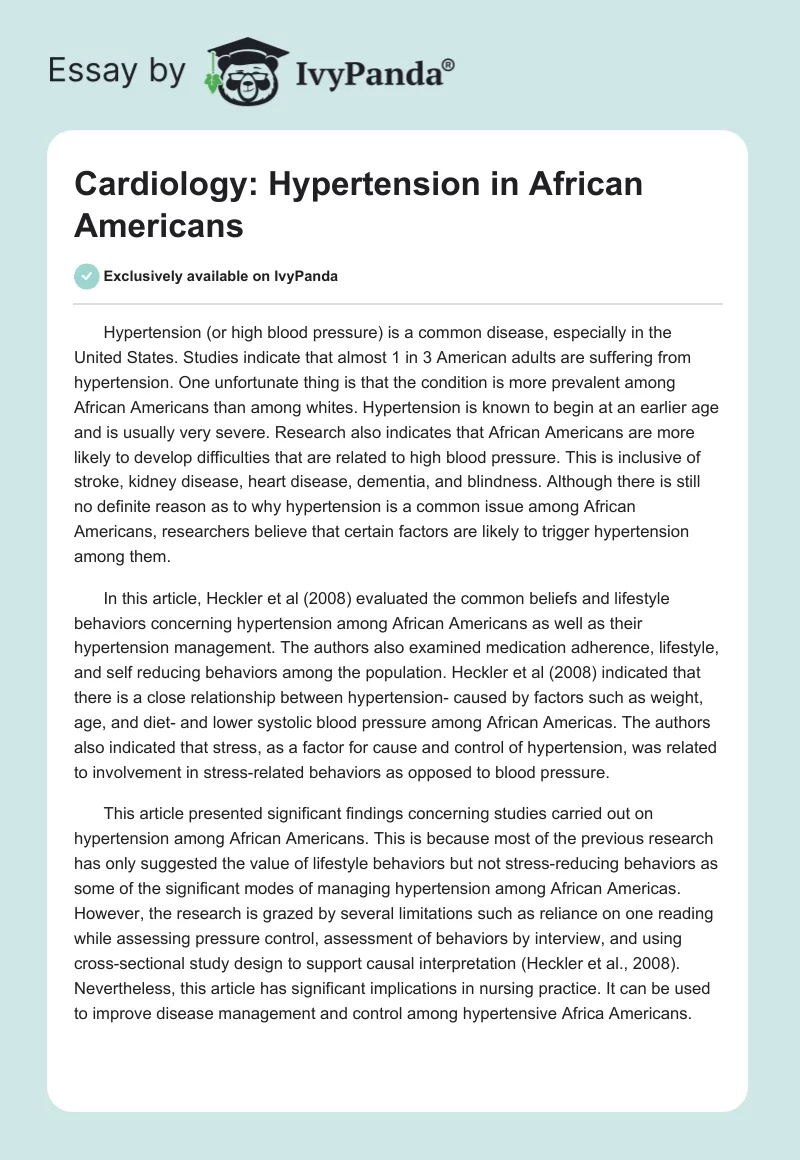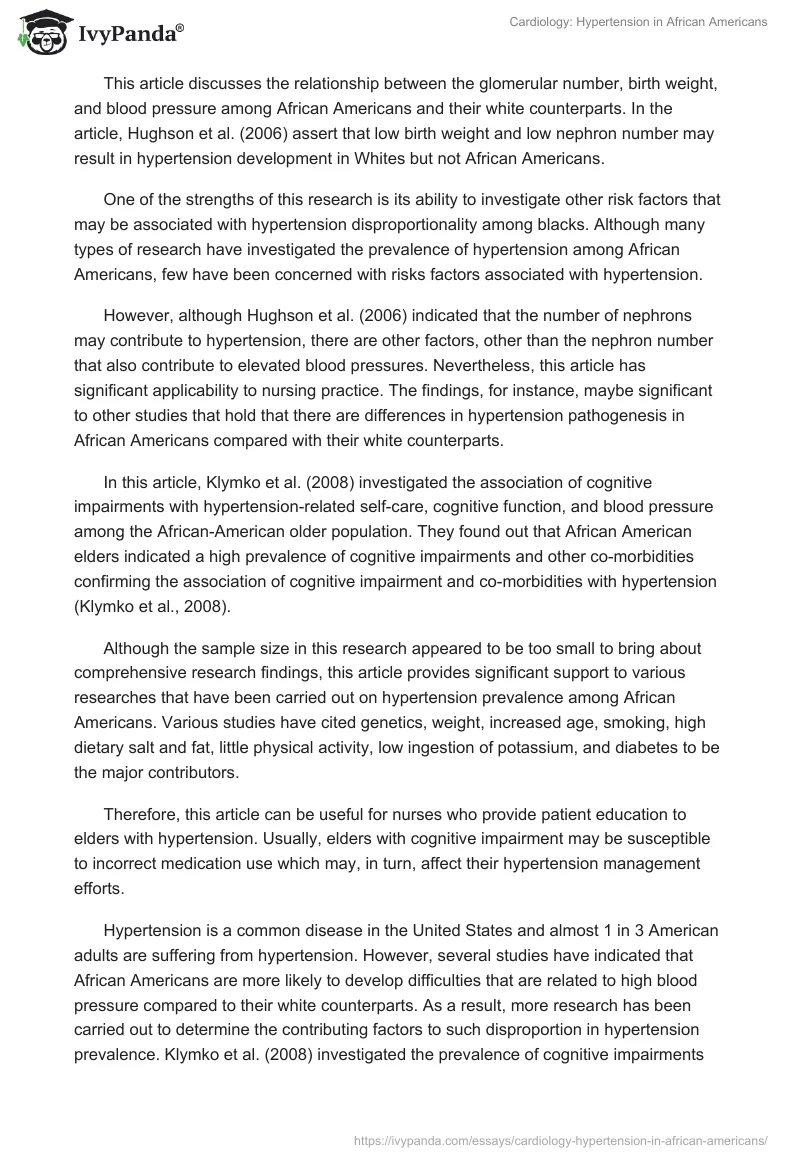Hypertension (or high blood pressure) is a common disease, especially in the United States. Studies indicate that almost 1 in 3 American adults are suffering from hypertension. One unfortunate thing is that the condition is more prevalent among African Americans than among whites. Hypertension is known to begin at an earlier age and is usually very severe. Research also indicates that African Americans are more likely to develop difficulties that are related to high blood pressure. This is inclusive of stroke, kidney disease, heart disease, dementia, and blindness. Although there is still no definite reason as to why hypertension is a common issue among African Americans, researchers believe that certain factors are likely to trigger hypertension among them.
Heckler, E. B., Lambert, J., Leventhal, E., Leventhal, H., Jahn, E., & Contrada, R.J. (2008). Common sense illness beliefs, adherence behaviors, and hypertension control among African Americans. Journal of Behavioral Medicine, 31: 391-400.
In this article, Heckler et al (2008) evaluated the common beliefs and lifestyle behaviors concerning hypertension among African Americans as well as their hypertension management. The authors also examined medication adherence, lifestyle, and self reducing behaviors among the population. Heckler et al (2008) indicated that there is a close relationship between hypertension- caused by factors such as weight, age, and diet- and lower systolic blood pressure among African Americas. The authors also indicated that stress, as a factor for cause and control of hypertension, was related to involvement in stress-related behaviors as opposed to blood pressure.
This article presented significant findings concerning studies carried out on hypertension among African Americans. This is because most of the previous research has only suggested the value of lifestyle behaviors but not stress-reducing behaviors as some of the significant modes of managing hypertension among African Americas. However, the research is grazed by several limitations such as reliance on one reading while assessing pressure control, assessment of behaviors by interview, and using cross-sectional study design to support causal interpretation (Heckler et al., 2008). Nevertheless, this article has significant implications in nursing practice. It can be used to improve disease management and control among hypertensive Africa Americans.
Hughson, M. D., Douglas-Denton, R., Bertram, J. F., & Hoy, W. E. (2006). Hypertension, glomerular number, and birth weight in African Americans and white subjects in the southeastern United States. International Society of Nephrology, 69, 671-678.
This article discusses the relationship between the glomerular number, birth weight, and blood pressure among African Americans and their white counterparts. In the article, Hughson et al. (2006) assert that low birth weight and low nephron number may result in hypertension development in Whites but not African Americans.
One of the strengths of this research is its ability to investigate other risk factors that may be associated with hypertension disproportionality among blacks. Although many types of research have investigated the prevalence of hypertension among African Americans, few have been concerned with risks factors associated with hypertension.
However, although Hughson et al. (2006) indicated that the number of nephrons may contribute to hypertension, there are other factors, other than the nephron number that also contribute to elevated blood pressures. Nevertheless, this article has significant applicability to nursing practice. The findings, for instance, maybe significant to other studies that hold that there are differences in hypertension pathogenesis in African Americans compared with their white counterparts.
Klymko, K.W., Artinmina, N.T., Washington, G.M., Lichtenberg, P. A, & Vander Wal, S.J. (2008). Effect of Impaired Cognition on Hypertension Outcomes in Older Urban African Americans. MEDSURG Nursing, 17(6): 405-410.
In this article, Klymko et al. (2008) investigated the association of cognitive impairments with hypertension-related self-care, cognitive function, and blood pressure among the African-American older population. They found out that African American elders indicated a high prevalence of cognitive impairments and other co-morbidities confirming the association of cognitive impairment and co-morbidities with hypertension (Klymko et al., 2008).
Although the sample size in this research appeared to be too small to bring about comprehensive research findings, this article provides significant support to various researches that have been carried out on hypertension prevalence among African Americans. Various studies have cited genetics, weight, increased age, smoking, high dietary salt and fat, little physical activity, low ingestion of potassium, and diabetes to be the major contributors.
Therefore, this article can be useful for nurses who provide patient education to elders with hypertension. Usually, elders with cognitive impairment may be susceptible to incorrect medication use which may, in turn, affect their hypertension management efforts.
Hypertension is a common disease in the United States and almost 1 in 3 American adults are suffering from hypertension. However, several studies have indicated that African Americans are more likely to develop difficulties that are related to high blood pressure compared to their white counterparts. As a result, more research has been carried out to determine the contributing factors to such disproportion in hypertension prevalence. Klymko et al. (2008) investigated the prevalence of cognitive impairments and examined the relationship among hypertension-related self-care, cognitive function, and blood pressure among the African-American older population. They indicated that African American elders showed a high prevalence of cognitive impairments and other co-morbidities confirming the association of cognitive impairment and co-morbidities with hypertension.
Another research by Hughson et al. (2006) investigated the relationship between the glomerular number, birth weight, and blood pressure among African Americans and their white counterparts. They asserted that low birth weight and low nephron number may result in hypertension development in Whites but not African Americans.
Heckler et al (2008) also examined the common sense beliefs and behaviors concerning hypertension among African Americans as well as their hypertension management concerning Leventhal’s commonsense model of self-regulation (CSM). They indicated that there is a close relationship between hypertension- caused by factors such as weight, age, and diet- and lower systolic blood pressure among African Americas (Heckler et al., 2008). Although various limitations were inherent in every study or article, these articles provided significant applicability to nursing practice.


